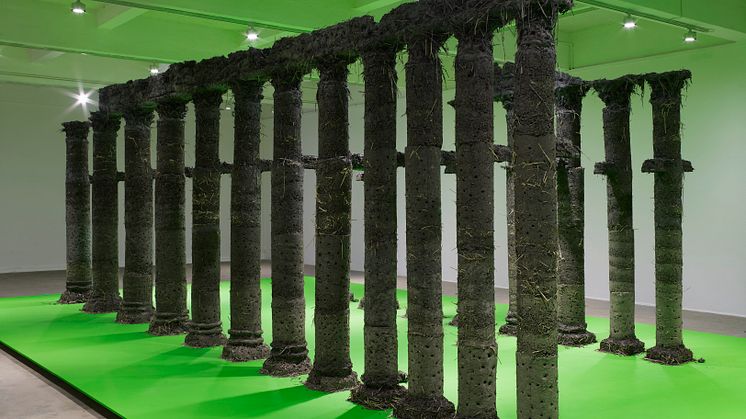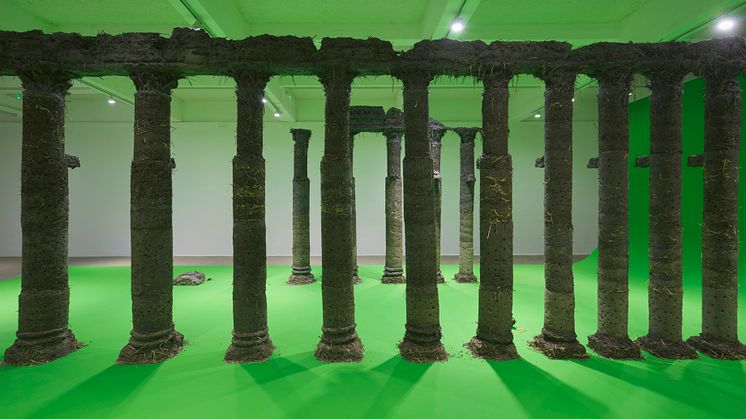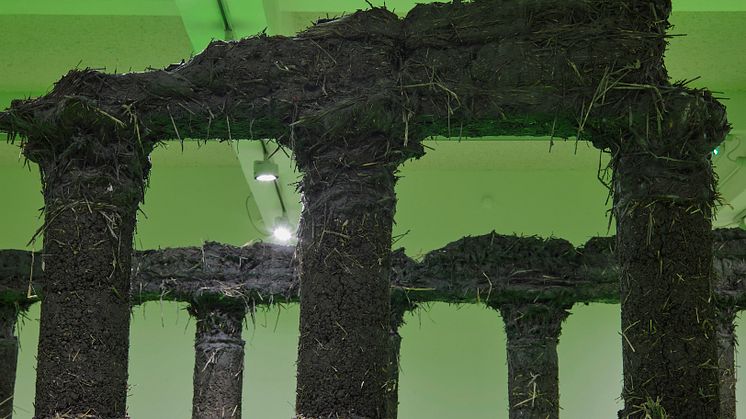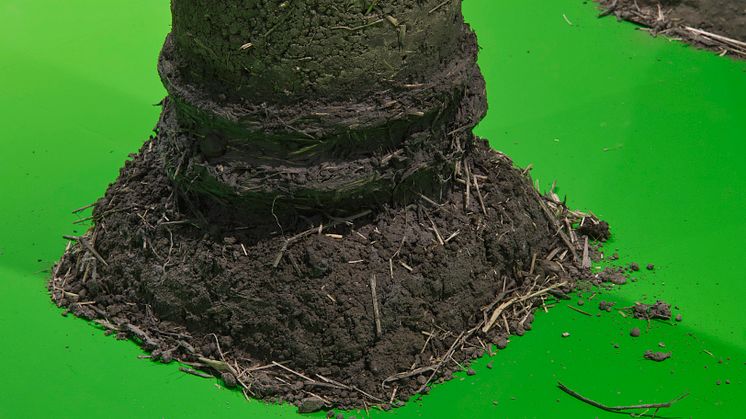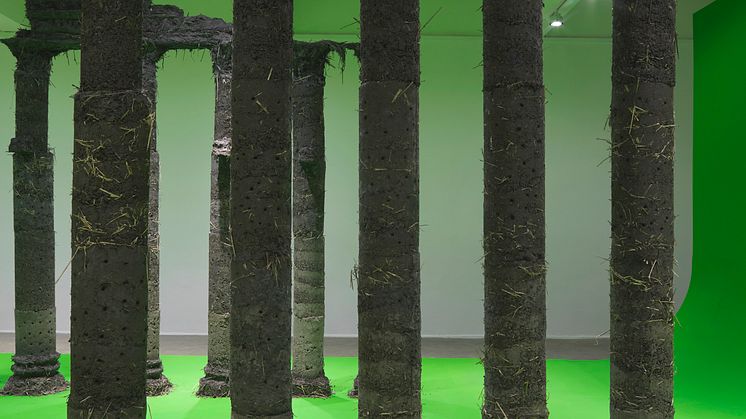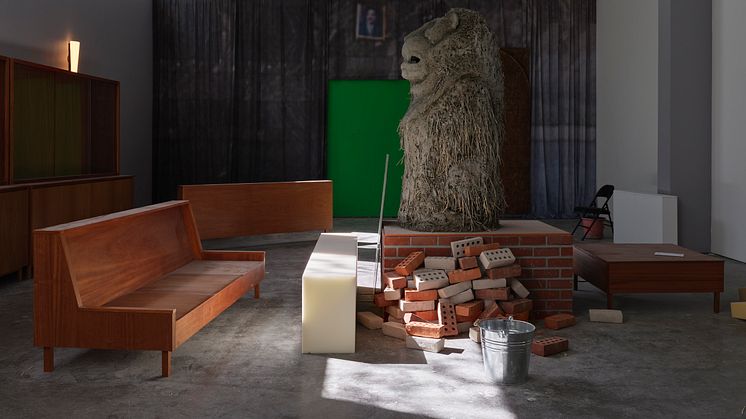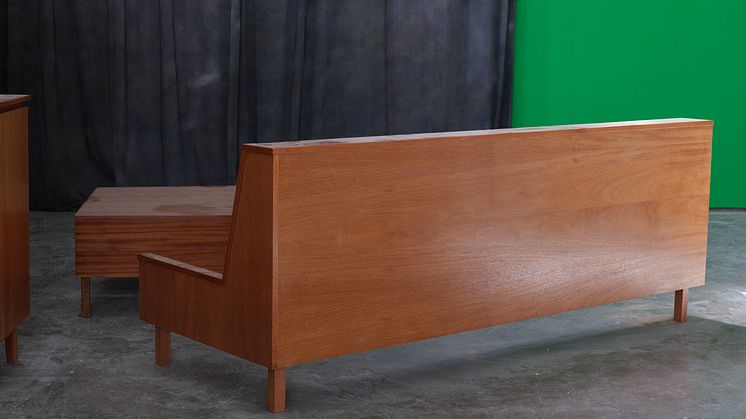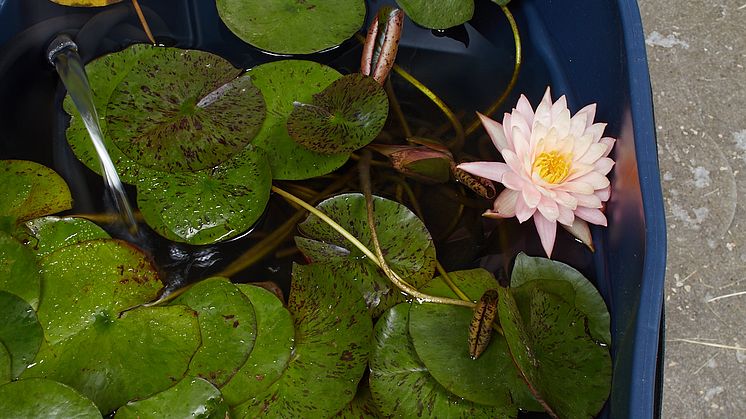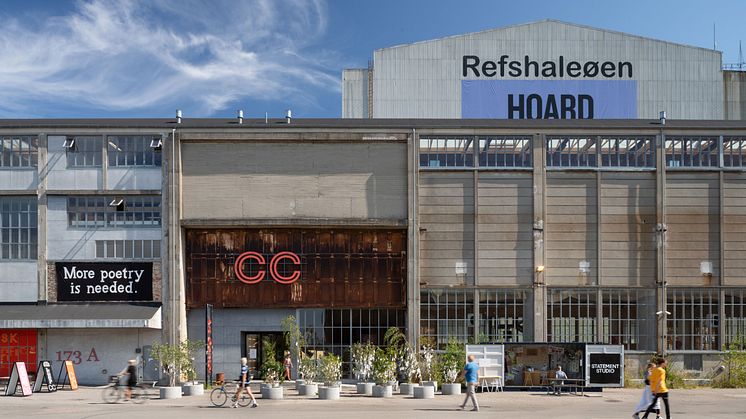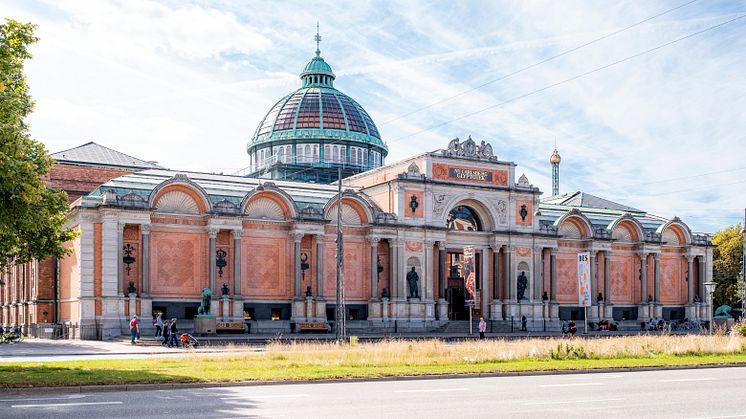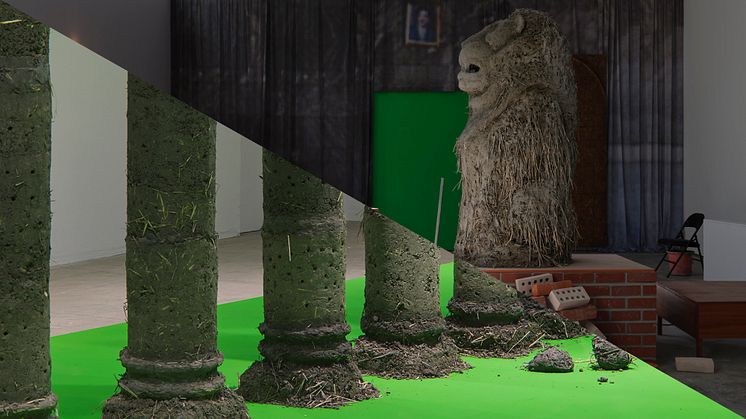
Press release -
International artist creates theatrical placeholders for ruined cultural heritage
For the first time in the Nordic region, Copenhagen Contemporary (CC) and the Glyptotek present a solo exhibition by the international artist Abbas Akhavan. The artist recreates Palmyra’s treasured columns and Iraq’s looted National Museum in an exhibition spanning the two art institutions. The works speak about Syria and Iraq’s lost and war-torn cultural heritage – exactly 20 years after the invasion of Iraq and 10 years after Palmyra was inscribed on UNESCO’s List of World Heritage in Danger. Akhavan’s exhibition curtain call is the first in a three-year series of exhibitions that will present new perspectives on Middle Eastern cultural heritage and its significance today.
A press preview will be held at CC and the Glyptotek on 21 June 09:30–12:00. Refreshments will be served and the exhibition’s curators and artist will give an introduction. For registration and interview requests, please contact ida@cphco.org

The world is full of untold and silenced stories transmitted for generations by people and artefacts migrating across time, borders and historical events. How should their stories be told and who has the right to tell them? In a new three-year exhibition collaboration, CC and the Glyptotek will shed light on some of the questions that arise in a global world where people and cultural heritage are constantly on the move.
The joint exhibition programme, Hosting Histories: Revisiting Cultural Heritage of the Middle East and Beyond, gives three international contemporary artists, either residing in the Middle Eastern region or belonging to Middle Eastern diasporas, access to the Glyptotek’s ancient collections and the opportunity to develop a solo exhibition across both institutions. Together with CC and the Glyptotek, the artists will revisit some of history’s silenced and untold stories and – through their own works – bring forward new perspectives on how these stories can be voiced today.
Ghostly revival of lost heritage
The first exhibition in the series is titled curtain call and created by the Montreal-based artist Abbas Akhavan (b. 1977, Tehran). In his first solo exhibition in the Nordic region, Akhavan presents two of his largest installations on view together for the first time: cast for a folly (2019–) and variations on a folly (2021–). With rustic columns, vibrating green screens and dusty, theatre props, Akhavan re-stages existing architectural sites and historical events displaced in time and place and unsettling in their message.
At the Glyptotek, the installation cast for a folly is shown exactly 20 years after the US invaded Iraq with allied countries including Denmark. The installation is a theatrical staging of a photograph of the lobby of the National Museum of Iraq in Baghdad, taken shortly after it was looted during the invasion of Iraq in 2003. The furniture is constructed in fragments and the Assyrian lion sculpture in heavy basalt has been resurrected out of cob, an ancient building material made from sand, clay, water and straw. A kicked-in door has become a green screen, while water lilies float in a plastic container. Now occupying a different time and space, the re-staging of the looted museum asks: Who inherits the ruins of war?
On display at CC is variations on a folly, a monumental architectural total installation where 19 five-metre-tall columns, also made of cob, rise on a gigantic green stage painted as a chroma key green screen, a technology typically used in the film and advertising industry to create new digital realities. A diffuse sound of pink noise lingers softly in the space. The work is a reference to the colonnade that once led up to the spectacular triumphal arch in Palmyra. There, in present-day Syria, are the ruins of a magnificent city that was once a cultural centre of the ancient world. The triumphal arch was destroyed during the Islamic State’s occupation of Palmyra in 2015. Subsequently it was replicated in marble by the British and American Institute for Digital Archaeology using 3D imaging technology and displayed in Trafalgar Square in London.
About the works, Abbas Akhavan says:
“While I am interested in ruins and care about the preservation of cultural heritage, the objective of these works isnot nostalgia for the Iraq Museum or Palmyra Arch, but rather the ways these sites become charged and disturbed as images in the collective imagination.”
Artefacts as cultural migrants
The curatorial objective of the first exhibition focuses on the travelling objects of cultural heritage and the notion of them as ‘cultural migrants’. Objects of cultural heritage are more than just physical traces of a bygone past; they hold their own stories, experiences, journeys and tragedies and, like people, they can become displaced as casualties or agents of war and geopolitical conflict. The exhibition curtain call addresses a range of open-ended questions spanning time, cultural differences and geographical distances.
Abbas Akhavan says:
“How do these artefacts circulate through other economies and narratives about re-mapping history, nation building and museum collecting? And what responsibilities do museums and cultural institutions have to history, heritage, artefacts and, more importantly, to the civilians that have produced and cultivated these sites? While Syrian refugees are being kept out of the rest of the world, their artefacts are getting asylum, either in reproduction or in real life.”
The two curators of the exhibition from CC and the Glyptotek supplement:
“Art and cultural artefacts have always migrated across borders as they have been traded and reused in new ways by other cultures and peoples. Today, many of these travelling objects are stored far from their place of origin. In this sense, they can be seen as cultural migrants, living a life today in involuntary diasporas – for example in encyclopaedic museums and private collections around the world,” says Anna Kærsgaard Gregersen, curator at the Glyptotek.
Aukje Lepoutre Ravn, curator at Copenhagen Contemporary, adds:
“Like contemporary culture, ancient heritage has thus operated on an international stage. But cultural heritage also plays a central role in the creation of national narratives. So, when artefacts migrate and remove themselves from their original context, difficult questions arise: When cultural heritage is detached from its original context, how and to whom should these artefacts be communicated and create value?”
About the artist:
Abbas Akhavan (b. 1977, Tehran) lives and works in Montreal. Recent solo exhibitions include Chisenhale Gallery, London (2021), CCA Wattis Institute, San Francisco (2019), Fogo Island Gallery, Fogo Island (2019) and Museum Villa Stuck, Munich (2017). He has participated in international group exhibitions, including the Gwangju Biennale (2023), Palais de Tokyo, Paris (2022), SALT Galata, Istanbul (2017) and the Solomon R. Guggenheim Museum, New York (2016). Akhavan is the recipient of the Fellbach Triennial Award (2017), Sobey Art Award (2015), Abraaj Group Art Prize (2014) and Berliner Kunstpreis (2012).
About the collaboration:
Two very different cultural institutions in Denmark, the largest institution for contemporary art Copenhagen Contemporary (CC) and the 126-year-old leading art museum Glyptoteket, have instigated an innovative and unconventional collaboration. Under the title Hosting Histories: Revisiting Cultural Heritage of the Middle East and Beyond the institutions will present three solo exhibitions with three international artists over the next three years (2023–25). The artists either reside in the Middle East or belong to Middle Eastern diasporas. In collaboration with curators from both institutions, the artists are given access to the Glyptotek’s Middle Eastern antiquities collections and, through their own work, interpret and reflect upon the significance of cultural heritage today. With this more than 3,000-year-old material as a historical backdrop, the artists create one exhibition spanning both institutions, contributing to broader and more contemporary storytelling about antiquity – stories that can increase our understanding of the ancient world’s diversity and mobility and, not least, that expand the notion of the geographical far beyond the national and cultural borders we know today.
The three-year exhibition programme Hosting Histories: Revisiting Cultural Heritage of the Middle East and Beyond between Glyptoteket and CC is generously supported by:
The Obel Family Foundation
The exhibition at Copenhagen Contemporary is further supported by:
A.P. Møller Foundation
The exhibition at Glyptoteket is further supported by:
Augustinus Fonden
Aage og Johanne Louis-Hansens Fond
Sportsgoodfonden
Danish Arts Foundation
The Crown Prince Frederik and Crown Princess Mary Foundation
Grosserer L.F. Foghts Fond
Ernst B. Sund Fonden
Lizzi and Mogens Staal Foundation
The artist’s stay is supported by:
The Canadian Embassy
Canada Council for the Arts
variations on a folly was originally commissioned by Chisenhale Gallery, London, in 2021. cast for a follywas originally commissioned by California College of the Arts (CCA) Wattis Institute, San Francisco, in 2019.
For more information about the exhibition, please contact:
Aukje Lepoutre Ravn, Senior Curator
aukje@cphco.org
+45 2098 9423
Press contact:
Ida Maj Ludvigsen, Head of PR & Communication
ida@cphco.org
+45 6021 9321
DOWNLOAD PRESS MATERIAL HERE: https://copenhagencontemporary.org/en/press/
Copenhagen Contemporary is in 2023 supported by:
Augustinusfonden, Bikubenfonden, Knud Højgaards Fond, Det Obelske Familiefond, Beckett-Fonden, Kulturministeriet, Københavns Kommune, Statens Kunstfond, Minister Erna Hamiltons Legat, Carlsbergs Mindelegat for Brygger J.C. Jacobsen, Goethe-Institut Dänemark, Refshaleøens Ejendomsselskab
Related links
Categories
Copenhagen Contemporary (CC) is Copenhagen’s international art center showing installation art created by world stars and new emerging talents. CC occupies the magnificent former B&W welding hall offering a total of 7,000 m2 of beautiful industrial halls with plenty of space to show the technical and large formats in which many contemporary artists work: total installations, performance art, and monumental video works.


